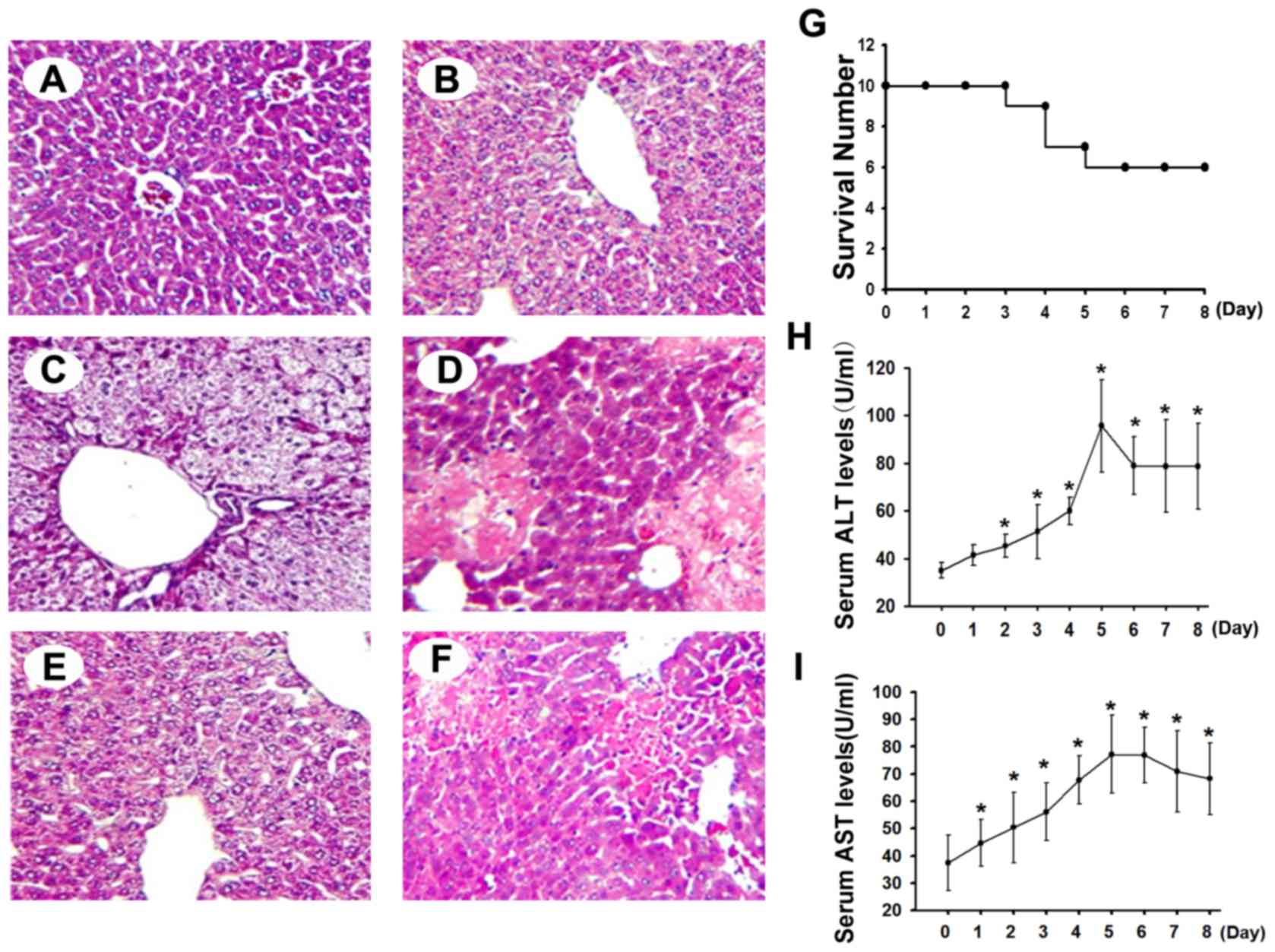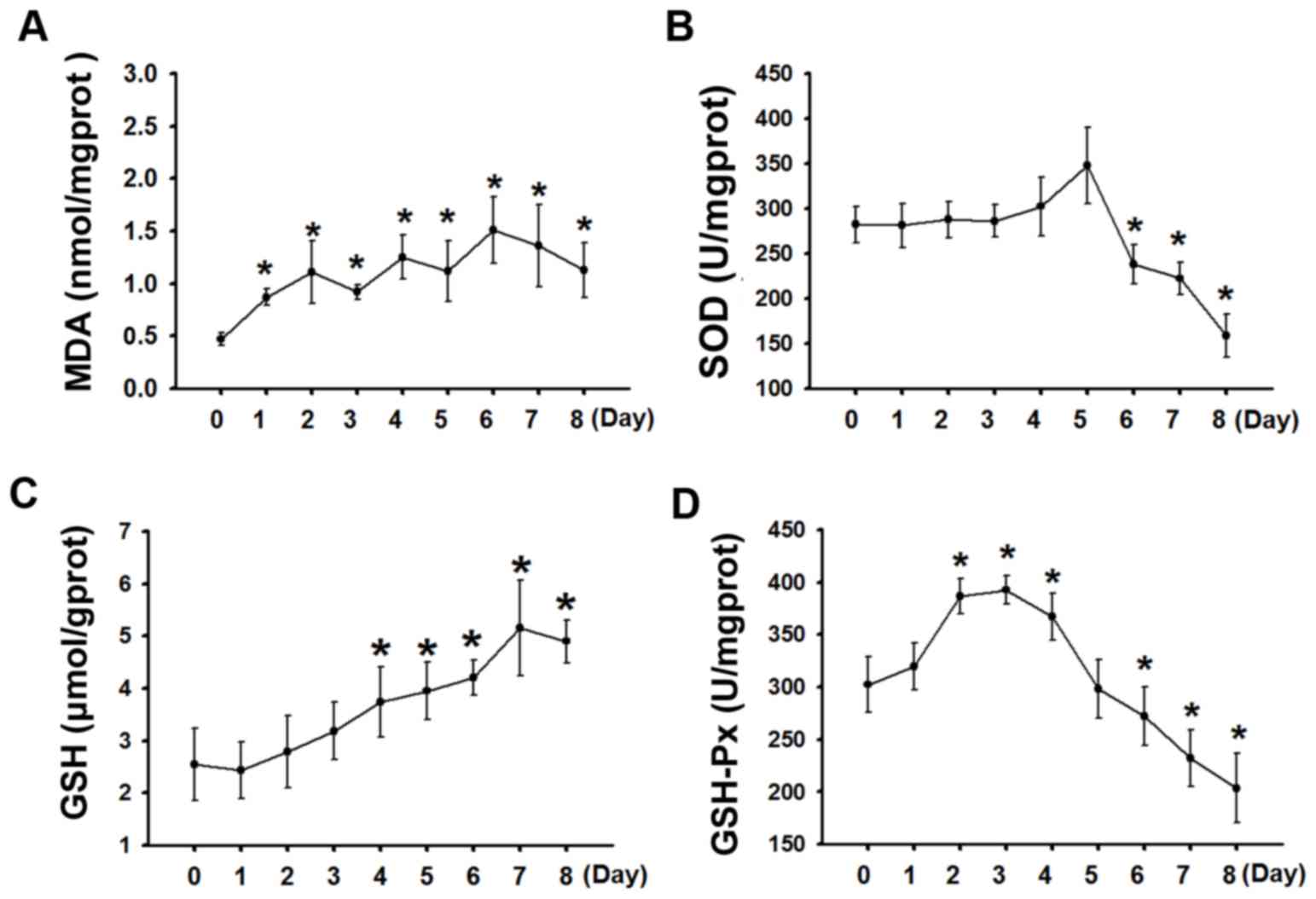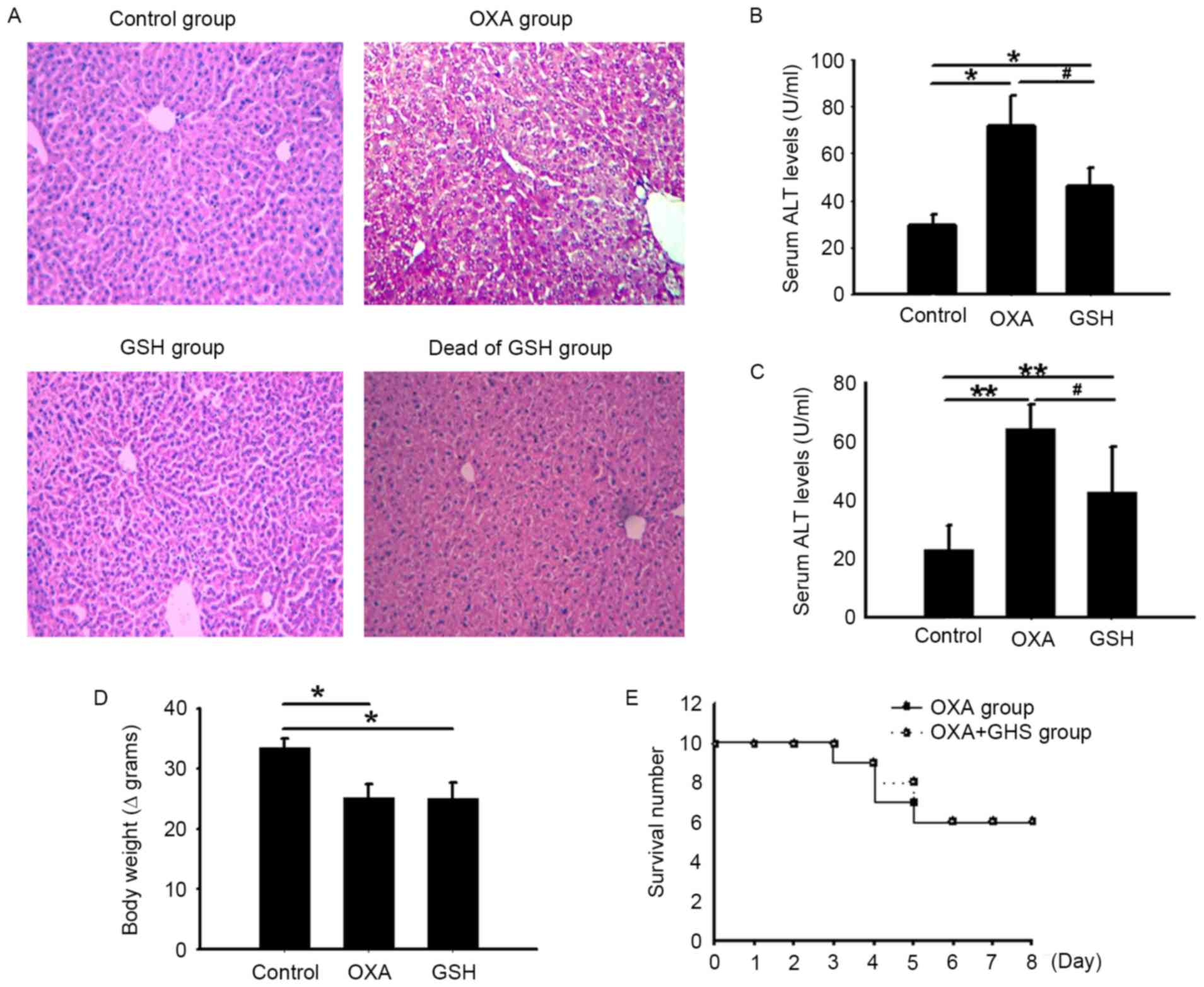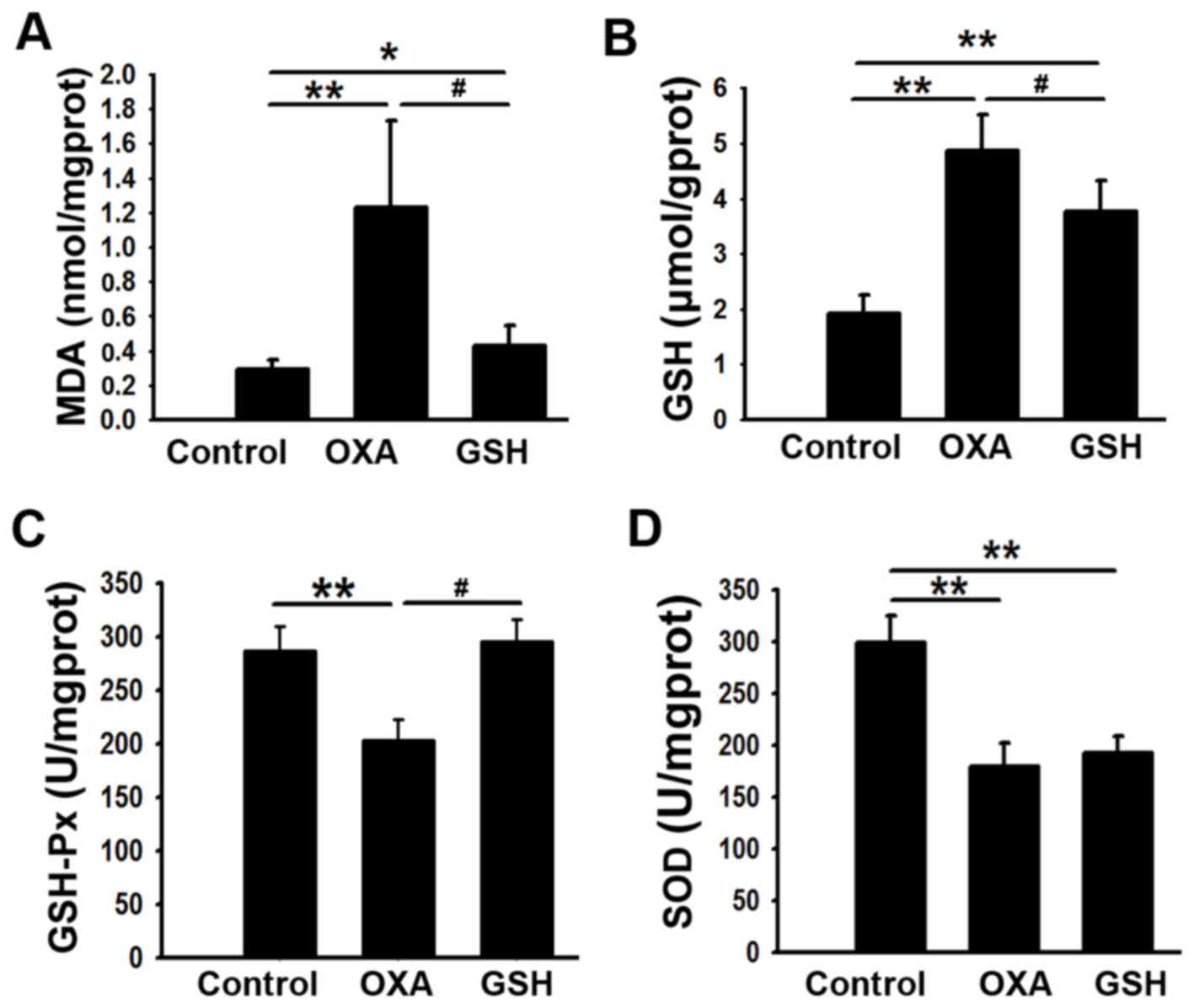|
1
|
Goldstein DA, Zeichner SB, Bartnik CM,
Neustadter E and Flowers CR: Metastatic colorectal cancer: A
systematic review of the value of current therapies. Clin
Colorectal Cancer. 15:1–6. 2016. View Article : Google Scholar : PubMed/NCBI
|
|
2
|
Rubbia-Brandt L, Audard V, Sartoretti P,
Roth AD, Brezault C, Le Charpentier M, Dousset B, Morel P, Soubrane
O, Chaussade S, et al: Severe hepatic sinusoidal obstruction
associated with oxaliplatin-based chemotherapy in patients with
metastatic colorectal cancer. Ann Oncol. 15:460–466. 2004.
View Article : Google Scholar : PubMed/NCBI
|
|
3
|
Tajima H, Ohta T, Miyashita T, Nakanuma S,
Matoba M, Miyata T, Sakai S, Okamoto K, Makino I, Kinoshita J, et
al: Oxaliplatin-based chemotherapy induces extravasated platelet
aggregation in the liver. Mol Clin Oncol. 3:555–558. 2015.
View Article : Google Scholar : PubMed/NCBI
|
|
4
|
Soubrane O, Brouquet A, Zalinski S, Terris
B, Brézault C, Mallet V, Goldwasser F and Scatton O: Predicting
high grade lesions of sinusoidal obstruction syndrome related to
oxaliplatin-based chemotherapy for colorectal liver metastases:
Correlation with post-hepatectomy outcome. Ann Surg. 251:454–460.
2010. View Article : Google Scholar : PubMed/NCBI
|
|
5
|
Nakano H, Oussoultzoglou E, Rosso E,
Casnedi S, Chenard-Neu MP, Dufour P, Bachellier P and Jaeck D:
Sinusoidal injury increases morbidity after major hepatectomy in
patients with colorectal liver metastases receiving preoperative
chemotherapy. Ann Surg. 247:118–124. 2008. View Article : Google Scholar : PubMed/NCBI
|
|
6
|
Nalbantoglu IL, Tan BR Jr, Linehan DC, Gao
F and Brunt EM: Histological features and severity of
oxaliplatin-induced liver injury and clinical associations. J Dig
Dis. 15:553–560. 2014. View Article : Google Scholar : PubMed/NCBI
|
|
7
|
Vreuls CP, Van Den Broek MA, Winstanley A,
Koek GH, Wisse E, Dejong CH, Damink Olde SW, Bosman FT and Driessen
A: Hepatic sinusoidal obstruction syndrome (SOS) reduces the effect
of oxaliplatin in colorectal liver metastases. Histopathology.
61:314–318. 2012. View Article : Google Scholar : PubMed/NCBI
|
|
8
|
Vincenzi B, Daniele S, Frezza AM, Berti P,
Vespasiani U, Picardi A and Tonini G: The role of
S-adenosylmethionine in preventing oxaliplatin-induced liver
toxicity: A retrospective analysis in metastatic colorectal cancer
patients treated with bevacizumab plus oxaliplatin-based regimen.
Support Care Cancer. 20:135–139. 2012. View Article : Google Scholar : PubMed/NCBI
|
|
9
|
Santoro V, Jia R, Thompson H, Nijhuis A,
Jeffery R, Kiakos K, Silver AR, Hartley JA and Hochhauser D: Role
of reactive oxygen species in the abrogation of oxaliplatin
activity by cetuximab in colorectal cancer. J Natl Cancer Inst.
108:djv3942015. View Article : Google Scholar : PubMed/NCBI
|
|
10
|
Robinson SM, Mann J, Vasilaki A, Mathers
J, Burt AD, Oakley F, White SA and Mann DA: Pathogenesis of FOLFOX
induced sinusoidal obstruction syndrome in a murine chemotherapy
model. J Hepatol. 59:318–326. 2013. View Article : Google Scholar : PubMed/NCBI
|
|
11
|
Schwingel TE, Klein CP, Nicoletti NF, Dora
CL, Hadrich G, Bica CG, Lopes TG, da Silva VD and Morrone FB:
Effects of the compounds resveratrol, rutin, quercetin, and
quercetin nanoemulsion on oxaliplatin-induced hepatotoxicity and
neurotoxicity in mice. Naunyn Schmiedebergs Arch Pharmacol.
387:837–848. 2014. View Article : Google Scholar : PubMed/NCBI
|
|
12
|
Azevedo MI, Pereira AF, Nogueira RB, Rolim
FE, Brito GA, Wong DV, Lima-Júnior RC, de Albuquerque Ribeiro R and
Vale ML: The antioxidant effects of the flavonoids rutin and
quercetin inhibit oxaliplatin-induced chronic painful peripheral
neuropathy. Mol Pain. 9:532013. View Article : Google Scholar : PubMed/NCBI
|
|
13
|
Carozzi VA, Marmiroli P and Cavaletti G:
The role of oxidative stress and anti-oxidant treatment in
platinum-induced peripheral neurotoxicity. Curr Cancer Drug
Targets. 10:670–682. 2010. View Article : Google Scholar : PubMed/NCBI
|
|
14
|
Chen Y, Dong H, Thompson DC, Shertzer HG,
Nebert DW and Vasiliou V: Glutathione defense mechanism in liver
injury: Insights from animal models. Food Chem Toxicol. 60:38–44.
2013. View Article : Google Scholar : PubMed/NCBI
|
|
15
|
Balendiran GK, Dabur R and Fraser D: The
role of glutathione in cancer. Cell Biochem Funct. 22:343–352.
2004. View
Article : Google Scholar : PubMed/NCBI
|
|
16
|
Khan AZ, Morris-Stiff G and Makuuchi M:
Patterns of chemotherapy-induced hepatic injury and their
implications for patients undergoing liver resection for colorectal
liver metastases. J Hepatobiliary Pancreat Surg. 16:137–144. 2009.
View Article : Google Scholar : PubMed/NCBI
|
|
17
|
Raschi E and De Ponti F: Drug- and
herb-induced liver injury: Progress, current challenges and
emerging signals of post-marketing risk. World J Hepatol.
7:1761–1771. 2015. View Article : Google Scholar : PubMed/NCBI
|
|
18
|
Fan CQ and Crawford JM: Sinusoidal
obstruction syndrome (hepatic veno-occlusive disease). J Clin Exp
Hepatol. 4:332–346. 2014. View Article : Google Scholar : PubMed/NCBI
|
|
19
|
Keizman D, Maimon N, Ish-Shalom M, Buchbut
D, Inbar M, Klein B, Bernheim J, Goldiner I, Leikin-Frenkel A and
Konikoff F: An animal model for chemotherapy-associated
steatohepatitis and its prevention by the oral administration of
fatty acid bile acid conjugate. Cancer. 116:251–255.
2010.PubMed/NCBI
|
|
20
|
de Andrade KQ, Moura FA, Dos Santos JM, de
Araújo OR, de Farias Santos JC and Goulart MO: Oxidative stress and
inflammation in hepatic diseases: Therapeutic possibilities of
N-acetylcysteine. Int J Mol Sci. 16:30269–30308. 2015. View Article : Google Scholar : PubMed/NCBI
|
|
21
|
Nielsen F, Mikkelsen BB, Nielsen JB,
Andersen HR and Grandjean P: Plasma malondialdehyde as biomarker
for oxidative stress: Reference interval and effects of life-style
factors. Clin Chem. 43:1209–1214. 1997.PubMed/NCBI
|
|
22
|
Xing H, Jia K, He J, Shi C, Fang M, Song
L, Zhang P, Zhao Y, Fu J and Li S: Establishment of the tree shrew
as an alcohol-induced Fatty liver model for the study of alcoholic
liver diseases. PLoS One. 10:e01282532015. View Article : Google Scholar : PubMed/NCBI
|
|
23
|
Curry-McCoy TV, Osna NA, Nanji AA and
Donohue TM Jr: Chronic ethanol consumption results in atypical
liver injury in copper/zinc superoxide dismutase deficient mice.
Alcohol Clin Exp Res. 34:251–261. 2010. View Article : Google Scholar : PubMed/NCBI
|
|
24
|
Bułdak RJ, Bułdak Ł, Kukla M, Gabriel A
and Zwirska-Korczala K: Significance of selected antioxidant
enzymes in cancer cell progression. Pol J Pathol. 65:167–175. 2014.
View Article : Google Scholar : PubMed/NCBI
|
|
25
|
Marzano C, Cazals-Hatem D, Rautou PE and
Valla DC: The significance of nonobstructive sinusoidal dilatation
of the liver: Impaired portal perfusion or inflammatory reaction
syndrome. Hepatology. 62:956–963. 2015. View Article : Google Scholar : PubMed/NCBI
|
|
26
|
Robinson SM, Mann DA, Manas DM, Oakley F,
Mann J and White SA: The potential contribution of tumour-related
factors to the development of FOLFOX-induced sinusoidal obstruction
syndrome. Br J Cancer. 109:2396–2403. 2013. View Article : Google Scholar : PubMed/NCBI
|
|
27
|
Rubbia-Brandt L, Tauzin S, Brezault C,
Delucinge-Vivier C, Descombes P, Dousset B, Majno PE, Mentha G and
Terris B: Gene expression profiling provides insights into pathways
of oxaliplatin-related sinusoidal obstruction syndrome in humans.
Mol Cancer Ther. 10:687–696. 2011. View Article : Google Scholar : PubMed/NCBI
|
|
28
|
Nishigori N, Matsumoto M, Koyama F,
Hayakawa M, Hatakeyayama K, Ko S, Fujimura Y and Nakajima Y: von
Willebrand factor-rich platelet thrombi in the liver cause
sinusoidal obstruction syndrome following oxaliplatin-based
chemotherapy. PLoS One. 10:e01431362015. View Article : Google Scholar : PubMed/NCBI
|
|
29
|
Paré-Brunet L, Sebio A, Salazar J,
Berenguer-Llergo A, Río E, Barnadas A, Baiget M and Páez D: Genetic
variations in the VEGF pathway as prognostic factors in metastatic
colorectal cancer patients treated with oxaliplatin-based
chemotherapy. Pharmacogenomics J. 15:397–404. 2015. View Article : Google Scholar : PubMed/NCBI
|
|
30
|
Imai K, Emi Y, Iyama KI, Beppu T, Ogata Y,
Kakeji Y, Samura H, Oki E, Akagi Y, Maehara Y, et al: Splenic
volume may be a useful indicator of the protective effect of
bevacizumab against oxaliplatin-induced hepatic sinusoidal
obstruction syndrome. Eur J Surg Oncol. 40:559–566. 2014.
View Article : Google Scholar : PubMed/NCBI
|
|
31
|
Arakawa Y, Shimada M, Utsunomiya T, Imura
S, Morine Y, Ikemoto T, Hanaoka J, Kanamoto M, Iwahashi S, Saito Y,
et al: Bevacizumab improves splenomegaly and decreases production
of hyaluronic acid after L-OHP based chemotherapy. Anticancer Res.
34:1953–1958. 2014.PubMed/NCBI
|


















